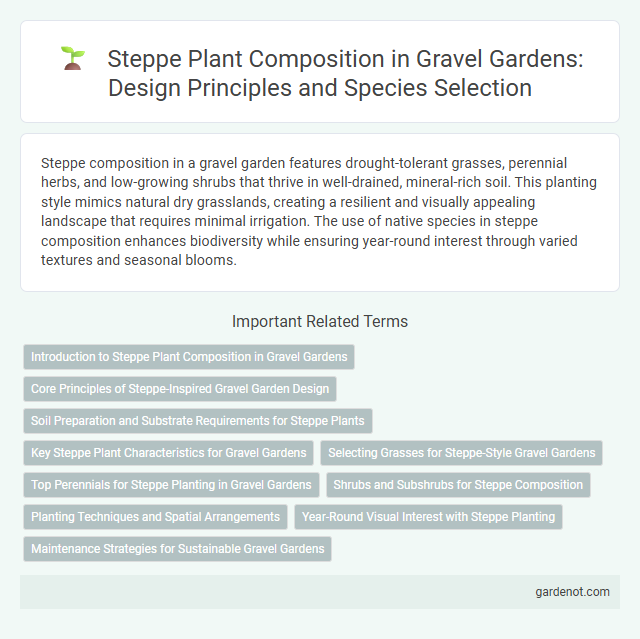Steppe composition in a gravel garden features drought-tolerant grasses, perennial herbs, and low-growing shrubs that thrive in well-drained, mineral-rich soil. This planting style mimics natural dry grasslands, creating a resilient and visually appealing landscape that requires minimal irrigation. The use of native species in steppe composition enhances biodiversity while ensuring year-round interest through varied textures and seasonal blooms.
Introduction to Steppe Plant Composition in Gravel Gardens
Steppe plant composition in gravel gardens emphasizes drought-tolerant species such as Stipa tenuissima, Allium flavum, and Artemisia species, which thrive in well-drained, nutrient-poor soils. These plants contribute to a naturalistic aesthetic that mimics the wild, open landscapes of Eurasian steppes, promoting biodiversity and resilience in xeriscapes. Incorporating native steppe grasses and perennials enhances soil stability and reduces maintenance requirements in gravel garden designs.
Core Principles of Steppe-Inspired Gravel Garden Design
Steppe-inspired gravel gardens emphasize drought-tolerant, native grasses and herbaceous perennials adapted to arid, well-drained soils. Key principles include selecting species with deep root systems for soil stabilization, incorporating mixed textures and heights to mimic natural steppe ecosystems, and optimizing gravel mulch for moisture retention and weed suppression. This composition enhances biodiversity while promoting sustainable, low-maintenance landscaping.
Soil Preparation and Substrate Requirements for Steppe Plants
Steppe plants require well-drained, nutrient-poor soil with a sandy or gritty substrate to mimic their natural arid habitat, essential for healthy root development. Soil preparation involves removing heavy clay or organic-rich materials, ensuring a loose, aerated structure that promotes water infiltration and reduces moisture retention. Incorporating coarse sand or gravel enhances drainage and prevents root rot, creating optimal conditions for drought-tolerant steppe species in a gravel garden environment.
Key Steppe Plant Characteristics for Gravel Gardens
Key steppe plants in gravel gardens exhibit drought tolerance, deep root systems, and adaptability to poor, well-drained soils, ensuring resilience in arid conditions. Their narrow, often gray-green leaves reduce water loss, while vibrant inflorescences provide seasonal interest and attract pollinators. Incorporating species like feather grass (Stipa), blue fescue (Festuca glauca), and various Artemisia cultivars enhances texture and structure, creating a sustainable, low-maintenance gravel garden.
Selecting Grasses for Steppe-Style Gravel Gardens
Selecting grasses for steppe-style gravel gardens emphasizes drought-tolerant species such as Festuca glauca, Stipa tenuissima, and Bouteloua gracilis, which thrive in well-drained, sandy soils. These grasses provide texture, movement, and a naturalistic aesthetic, mimicking native steppe ecosystems while requiring minimal water and maintenance. Incorporating native bunchgrasses enhances biodiversity and supports pollinators adapted to arid environments.
Top Perennials for Steppe Planting in Gravel Gardens
Top perennials for steppe planting in gravel gardens include drought-tolerant species such as Echinacea purpurea, Rudbeckia hirta, and Salvia nemorosa, which thrive in well-drained, nutrient-poor soils. These hardy plants provide vibrant color and texture while supporting pollinators and requiring minimal water, aligning perfectly with sustainable garden practices. Incorporating native grasses like Stipa tenuissima enhances the naturalistic steppe aesthetic and promotes biodiversity in gravel garden landscapes.
Shrubs and Subshrubs for Steppe Composition
Steppe compositions in gravel gardens prominently feature drought-tolerant shrubs and subshrubs such as Artemisia, Russian Sage (Perovskia atriplicifolia), and Cotoneaster, which thrive in well-drained, nutrient-poor soils. These woody plants provide structural diversity, support local biodiversity, and require minimal irrigation, making them ideal for xeriscaping in arid or semi-arid climates. Their deep root systems stabilize the gravel substrate and enhance soil health through organic matter accumulation and microbial activity.
Planting Techniques and Spatial Arrangements
Steppe composition in gravel gardens emphasizes drought-tolerant, deep-rooted grasses and perennials arranged in naturalistic clusters to mimic open landscapes. Planting techniques involve grouping species with similar water and sunlight needs while ensuring proper soil drainage to prevent root rot. Spatial arrangements prioritize layering heights and textures, creating dynamic visual interest and facilitating airflow to enhance plant health.
Year-Round Visual Interest with Steppe Planting
Steppe composition in gravel gardens maximizes year-round visual interest by incorporating drought-tolerant grasses and perennials that thrive in well-drained, nutrient-poor soils. Species such as Stipa tenuissima, Salvia nemorosa, and Eryngium amethystinum provide dynamic textures and seasonal color variations from early spring through late autumn. This planting strategy enhances biodiversity while reducing maintenance and water consumption, creating sustainable and visually engaging landscapes.
Maintenance Strategies for Sustainable Gravel Gardens
Steppe composition in gravel gardens emphasizes drought-tolerant and low-maintenance plant species such as Stipa tenuissima and Artemisia, which thrive in well-drained, nutrient-poor soils. Effective maintenance strategies include minimal watering schedules aligned with the plants' natural drought resilience, periodic mulching with gravel to suppress weeds and enhance soil moisture retention, and seasonal pruning to encourage growth without disturbing the soil structure. Sustainable gravel gardens benefit from soil testing every few years to monitor nutrient levels and prevent over-fertilization, maintaining ecological balance and plant vitality.
Steppe composition Infographic

 gardenot.com
gardenot.com